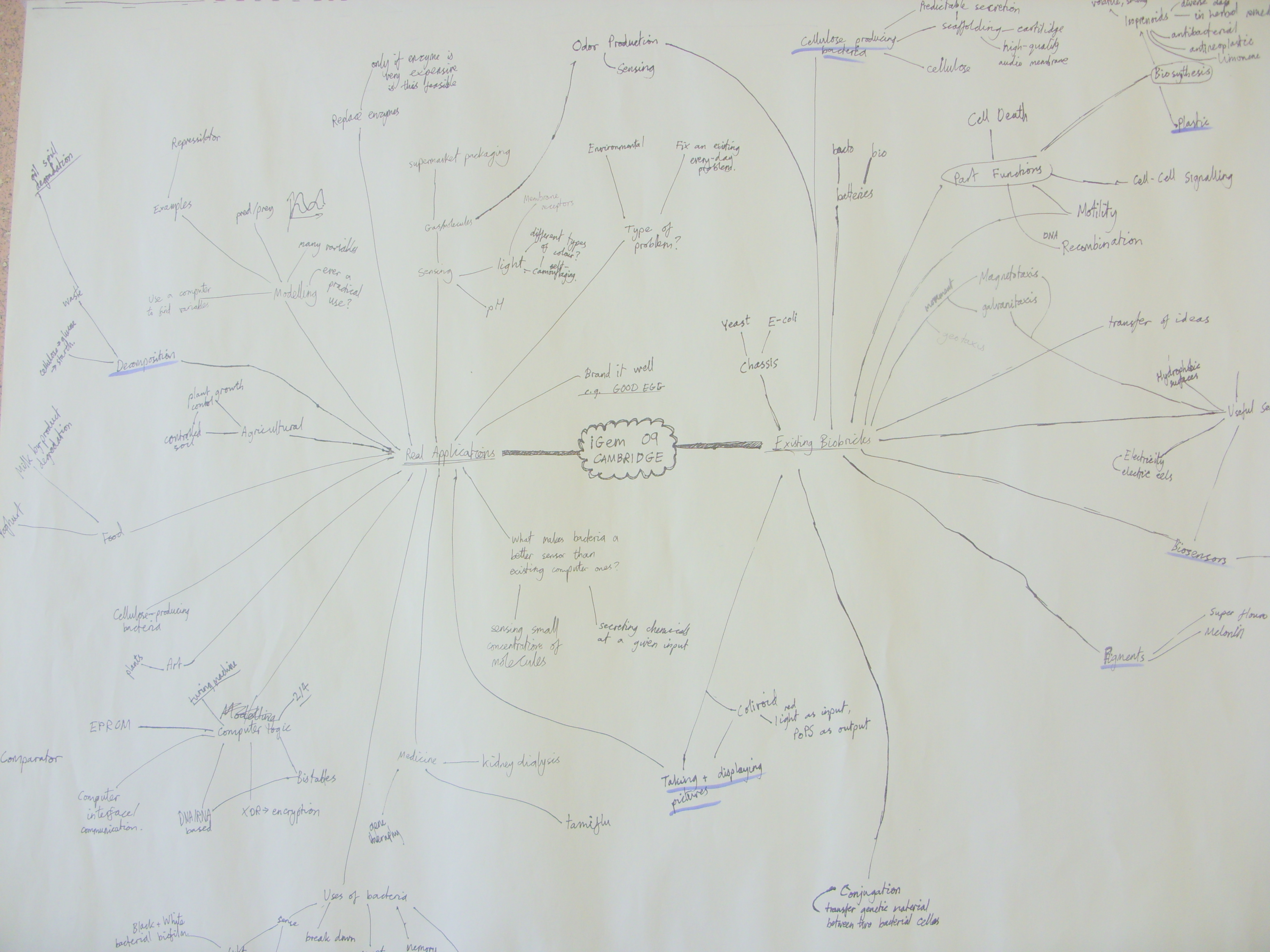Team:Cambridge/Notebook/Week1
From 2009.igem.org
Categories :
Project :
-
Overview
Sensitivity Tuner
--- Characterisation
--- Modelling
Colour Generators
--- Carotenoids (Orange/Red)
--- Melanin (Brown)
--- Violacein (Purple/Green)
The Future
Safety
Notebook :
Team Logistics :
Week 1 - Planning
Ideas are discussed - we decide to concentrate on pigment outputs - Different colours are researched - we come up with the possibilites of red, orange, green, violet, blue and brown
Monday
Brainstorming; each team member researched their own ideas for our project.
To see our Mind Map, click the image on the right:
Tuesday
Afternoon presentations - possible projects included
- Bacto-Stat
- Counterfeit Bill Detector
- Traffic light-obedient bacteria
- Light-induced pigment production
- Predator prey bacteria + a parasite
- Modelling pesticide resistance
- Galvanotaxis
- Wave-pulse bacteria
- Ai2 quorum sensing system
Conclusions
Decided to concentrate on a pigment output. Wednesday plans involve discussing ideas for pigments, following the same meeting pattern used on Tuesday. Ideally the pigment output would be a new registry part which could then be connected to any input system
Wednesday
Investigated possible outputs, with a kind of bacterial printer in mind.
Colour Wheels
3 possible kinds of colour wheels were thought out. By using bacteria producing each of the three colour in a wheel, a wide range of colours may be created by altering the ratios:
- Primary school style: BLUE, YELLOW, RED
- True colour wheel: YELLOW, CYAN, MAGENTA
- Autochrome: ORANGE, GREEN, VIOLET
Viable Pigments
- In an ideal system, we would have lots of pathways making different coloured pigments from a common precursor. One can dream...
- Carotenoids - RED, ORANGE, YELLOW
- Biobricks exist for part of the system
- Apparently you can go from yellow to white (cool)
Paper: http://aem.asm.org/cgi/content/abstract/73/4/1355
- Pseudomons aeruginosa - RED, GREENISH/BLUE
- Pyocyanin is greenish/blue, can be synthesized from chorismic acid, or more simply, from phenazine-1-carboxylic acid (PCA)
- Knocking out one of the genes between PCA and pyocyanin leads to the production of a red pigment
Paper: http://jb.asm.org/cgi/content/abstract/183/21/6454
- Chromobacterium violacein - VIOLET, AQUA
- Violacein is a violet pigment
- A precursor is aqua.
Paper: http://www.horizonpress.com/jmmb/v2/v2n4/26.pdf
- BROWN
- Melanin - easily attainable
- Anyway we could make black?
Follow ups for tomorrow
- Possible inputs
- Population control
- Bacterial chlorophyll?
Thursday
Hoping to start wet work on Monday!
Pigments
- Duncan has orange and brown bacteria we can start to work with. The melanin gene has been sequenced, has a restriction site we would need to remove to submit it to the registry.
- We have the genes for violacein! However there seem to be several internal restriction sites within the plasmid that would need to be removed.
- Contacted the authors of a paper to get the genes for pyocyanin biosynthesis. Two of them have forbidden restriciton sites, so we'll need to figure out how to remove them.
Inputs
- Explored the idea of using common repressor / inducer systems - arabinose, lac repressor, and tet repressor - to control pigment production
- Scourged the registry for lots of different inducible promoters
Population Control
- Crispian proposed a growth control dependency pathway that would make the growth of each type of bacterium (red colour-producing, blue colour-producing, yellow colour-producing, for example) dependent on one other using HSLs
Friday
- Found where to get PCA, pyocyanin precursor
- Did an inventory of supplies
- Familiarized ourselves with protocols and planned for next week's wet work
- Thinking about a team logo
Current plans for the wet work involve starting transformation of the bacteria in order to view the pigment colours and intensities. For this we will need to create competent cells and then use Duncan's plasmids to transform the violet and brown and the biobrick registary parts to transform the red and orange.
 "
"
